Link back to the Teacher’s Guide Table of Contents
Unit 4 Table of Contents
- Introduction: Sequencing Unit 4
- Week 12: Cell Division and the Cell Cycle
- Week 13: Cell Communication and Cell Signaling
- Week 14: Finish Cell Communication; Cell Cycle Regulation
- Week 15: Feedback/Homeostasis
- Summative Activities for Unit 4
Essential Links
- The College Board’s AP Bio Course and Exam Description.
- My Condensed Version of the Course and Exam Description: takes the objectives, Enduring understandings, and key ideas of the 230-page CED and renders it into 40 pages.
- My AP Exam Review Outline: Takes the Course and Exam description and renders it into student (and teacher) friendly language.
- 2023-24 AP Bio Scope and Sequence Calendar: A spreadsheet that lays out the entire course.
An important note about what follows Unit 4: 6 before 5!
Before moving into Unit 4, I want to talk about what comes after Unit 4. While Learn-Biology will support whatever sequence you follow, I strongly suggest that you follow Unit 4 (Cell Communication, Feedback, and Cell Division) with Unit 6 (Molecular Genetics) and then come back to Unit 5 (Heredity). Here’s why.
1. It continues the small to big trajectory that our course has been (mostly) following.
The College Board’s Course and Exam Description (linked above) mostly follows a small to big sequence. Unit 1 is molecules, Unit 2 is cells. Unit 3 is energetics but at a cellular level (enzymes, photosynthesis, and respiration). Unit 4 is also mostly cell biology: cell communication and cell division, with feedback and homeostasis (topic 4.5) sandwiched in between. To me, it makes much more sense to stay at the cellular/molecular level, which is what Unit 6 addresses, before moving onto the organismal level, which is what most of Unit 5 (Heredity), is about.
2. Doing 6 before 5 Makes Unit 5 Much Easier.
It makes much more sense for our students to understand what genes are and how they work (all covered in unit 6) before looking at how genes are transmitted from generation to generation and how they’re recombined. If you do that, you’ll also find that many HHMI activities related to heredity will make much more sense to your students. I’m thinking of this activity about Pedigrees and the Persistence of Lactose Intolerance or this one (also from HHMI) entitled Inheritance and Mutations in a Single Gene Disorder (about sickle cell disease).
3. Doing 6 before 5 Puts 5 before 7, and that Makes Unit 7 Easier
Finally, in terms of moving forward, I like to move from Mendelian Genetics (which is in Unit 5) to Population Genetics (which is what kicks off Unit 7).
That having been said, if you prefer to do Unit 5 first don’t worry. You can get Unit 5 guidance from our AP Bio Teacher’s guide.
Also, just so you know, I had to do Unit 5 before Unit 6 in 2022-23 (it’s a long story), and it worked (but not as well as previous years when I did 6 before 5).
Note that if you’re following my email newsletter, you’ll see this sequence (6 before 5) reflected as I guide you through the material in Learn-Biology.com, as well as through the related classroom activities. So I hope you’ll follow me in doing Unit 6 before Unit 5. But if you don’t, don’t fret: our tutorials will be just as effective, whatever order you choose to do them in.
Unit 4 Introduction and Suggested Sequence
Unit 4 consists of three topics: cell communication, feedback and homeostasis, and cell division. While that’s the order that you’ll find in the College Board’s Course and Exam description, I recommend you use the following sequence (the links go to tutorials on Learn-Biology.com).
- Topic 4.6: Mitosis and the Cell Cycle
- Topics 4.1 to 4.4: Cell Communication and Cell Signaling (the whole unit)
- Topic 4.7. Regulation of the cell cycle, including Cancer and Apoptosis
- Topic 4.5, Feedback and Homeostasis
Why that sequence? Why make three topics into four? Here’s why. You’ve just finished cellular energetics, a pretty tough topic. Before teaching cell communication (a very tough topic)I like to give my students a break by teaching them about cell division and the cell cycle (pretty easy stuff). But I don’t teach all of cell division: I leave regulation of the cell cycle for after cell communication. That’s because cell cycle regulation is largely about cell communication. It makes sense to teach about kinases first, and then come back and use that knowledge to explain cell cycle regulation.
Once that’s done, we move into Feedback and Homeostasis, which is a completely separate topic (and could be taught anywhere in the course).
Week 12, Cell Division and the Cell Cycle
Objectives for Cell Division and the Cell Cycle (Topic 4.6)
You can see the College Board’s original objectives for Topic 4.6 in their Course and Exam Description, or in my condensed version of the same document (links are above). Here are these objectives in student-friendly form.
- Compare and contrast cell division in prokaryotes and eukaryotes (binary fission v. mitosis).
- Describe the functions of cell division in eukaryotes (asexual reproduction; growth and repair).
- Explain the phases of the cell cycle (interphase, G1, S, G2, M)
- Explain the importance of the G0 phase.
- Describe, on a big-picture level, what happens in mitosis (cloning of a parent cell’s entire genome into two genetically identical daughter cells)
- List and describe the phases of mitosis.
Note that you can find objectives and teaching tips for cell cycle regulation (topic 4.7) below in week 14.
Cell Division tutorials on Learn-Biology.com
Learn-Biology organizes learning about cell division into three tutorials, supported by this student learning guide. Remember that my advice is that you have your students do the first tutorial, then move on to cell communication, then come back and finish the rest of this topic
- Topic 4.6: Mitosis and the Cell Cycle (do this now)
- Topic 4.7, Part 1: Cell Cycle Regulation (do this and the next after cell communication)
- Topic 4.7, Part 2: Cancer and Apoptosis
Cell Division Labs and Other Activities
The “classic” lab about cell division involves examining onion root tips. You can do this with prepared slides (that you can get from supply houses like Carolina Biological or Flinn Scientific), or you can grow your own. You can start with green onions from any supermarket. In that case, you can run a true experiment, exposing half of the plants to some substance (the experimental variable) and keeping the other half as a control. Then you do root tip squashes and compare the number of cells in interphase, prophase, metaphase, anaphase, and telophase.
Here’s a link to a very simple version using prepared slides.
Here’s a link to a webpage that describes how to prepare slides yourself. Full disclosure: I haven’t ever done this with my students.
Week 13, Cell Communication and Signal Transduction
Some general notes about teaching cell communication
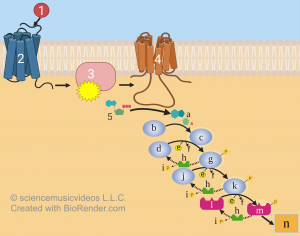
Cell communication and signal transduction are some of the coolest topics in biology. Just think about what you’re going to achieve. If you begin with the end in mind (the 2nd habit in Stephen Covey’s Seven Habits of Highly Effective People), you can think of your task as getting your students to be able to explain what’s going on in the diagram on the left. Adding a narrative frame, you can imagine your task as enabling your students to tell the story of what happens when liver cells receive an epinephrine signal telling them that it’s time to convert stored glycogen into glucose and to release that glucose into the bloodstream.
If at the end of the unit, your students can explain the diagram and tell that story, you’ve earned your pay. You’re gonna get there.
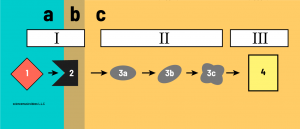
The way to do this (which I’ve embedded in my tutorials on cell communication) is to break this down into manageable chunks, starting with diagrams like the one at right. That diagram, emphasizing reception, transduction, and cellular response, was, essentially, an FRQ on a past AP Bio exam. So even getting to mastery of that is going to benefit your students. The deeper you go, the more interesting the biology.
I try to use a lot of storytelling to help students bind this material together. The story I tell my students (which doesn’t explicitly show up in my tutorials) is this, and I’m sure you have your own version. I’m walking through a parking lot. I pass a pickup truck that has its window rolled just a bit down. As I pass, a big dog inside the pickup lunges at me, barking and snarling. I’m safe (because of the window) but I’m experiencing a full-on, sympathetic response: my heart is pounding, my skin is flushed, etc. I tell my students that if my blood sugar level had been measured at that moment, there would have been a huge spike upwards. Why? Because epinephrine, as part of the fight or flight response, stimulates liver cells to break down glycogen to release glucose. This story is something that I come back to during every phase of the lesson.
Another good instructional move is to see what you’re doing as teaching a general concept that you’ll get to teach at deeper levels throughout the course. You’ll be able to use cell communication-related concepts when you teach topics such as:
- The control of cell division (which you’ll teach in just about a week).
- Sex determination (expression of the SRY gene leading to masculinization in most mammals),
- Blood glucose homeostasis (epinephrine and glucagon work through very similar mechanisms),
- HOX genes during development
- Fruit ripening (as an illustrative example of a positive feedback loop).
Note that you don’t have to teach all of these (and only three of these show up in our tutorials— cell division, blood glucose homeostasis, and HOX genes)
Finally, it’s important not to lose the forest for the trees. Always remember to channel Dobzhansky, and teach what’s happening from an evolutionary perspective. Signal transduction is an adaptation. These signaling systems allow the cell to stand on a hair trigger alert, instantly changing state in response to a signal, and then, just as quickly, turning that response off. It’s all about the amplification of a signal in the service of survival.
Objectives for Cell Communication and the Signal Transduction (Topics 4.1 – 4.4)
As I explain above, I use the story of epinephrine, liver cells, and glucose secretion as my way of binding this entire unit together. So standing above these other objectives is this one:
Explain how epinephrine leads liver tissue to secrete glucose. The student’s response should fully explain the workings of a G-protein coupled receptor, signal transduction, and amplification through a phosphorylation cascade, and cellular response.
Objectives 1c, 2, 3, 4, 5, and 6 below will show up in the task above.
You can see the College Board’s original objectives for Topics 4.1 – 4.4 in their Course and Exam Description, or in my condensed version of the same document (links are above). Here are these objectives in student-friendly form.
- Describe three ways that cells communicate with one another, and provide examples of each one.
- Cell-to-cell contact (examples: immune signaling, plasmodesmata)
- Short-distance signaling using local regulators (examples: neurotransmitters, quorum sensing, morphogens during embryonic development)
- Long-distance signaling (examples: endocrine signaling, including human growth hormone and insulin; steroid hormones such as estrogen and testosterone).
- Describe the function of signal transduction (linking signal reception with a cellular response)
- List the three components of signal transduction systems (reception, transduction, response)
- Describe the key features of reception (specific receptors — usually membrane proteins — binding with ligands).
- Describe the key features of signal transduction (ligand binding leading to changes in the intracellular domain of a membrane protein; propagation of the signal to and through second messengers such as cyclic AMP; amplification of the signal through phosphorylation cascades).
- List examples of cellular responses that result from signal transduction (examples: cell division, secretion of molecules, gene expression, apoptosis).
- Explain how changes in the components of a signaling system (ligand, receptor, transduction components) can alter cellular responses. (note: CML, caused by the Philadelphia chromosome, and the anti-cancer drug Gleevec is a fantastic example of this. You can save that for later in the year when you teach about mutation).
Cell Communication tutorials on Learn-Biology.com
Learn-Biology organizes learning about cell communication into five tutorials, supported by this Student Learning Guide
- Topic 4.1: Introduction to Cell Communication
- Topics 4.2 – 4.4, Part 1: Introduction to Signal Transduction
- Topics 4.2 – 4.4, Part 2: Reception
- Topics 4.2 – 4.4, Part 3: Signal Transduction
- Topics 4.2 – 4.4 Part 3: Signaling Hormones and Gene Regulation
- Topics 4-1 – 4.4 (Cell Communication and Signal Transduction) Cumulative Quiz
Cell Communication Activities
Flinn has two very good POGILS related to this topic. The first focuses on cell communication and the second one on signal Transduction.
HHMI has a lesson about The Biochemistry and Cell Signaling Pathway of MC1R. MC1R is the melanocortin 1 receptor, and variations in this receptor’s structure explain the difference between light and dark forms of the Rock Pocket mouse. If you completed the first part of this activity at the start of the year (a video and worksheet), then this provides you with a great opportunity to connect cell communication and signaling pathways to natural selection and to review protein structure. Even though you haven’t yet taught about mutation, your students should be able to handle the activity (and doing it now will give you a great illustrative example when you teach about mutation later in the year. HHMI provides you with this teacher’s guide. If you haven’t yet taught about the rock pocket mouse, see my instructions in the Unit 1 teacher’s guide. If you have taught about it, HHMI provides this one-minute quick review video on YouTube.
Another widely done lab related to cell communication is the Gymnema Tea Party Lab. Gymnema tea blocks taste receptors that detect sweet tastes. Here’s a copy of the handout that I’ve used in the classroom. The last section (an article about taste reception needs editing (which I haven’t yet been able to do: sorry!). In addition, here is a great resource that you can use to develop your own version of the lab.
Week 14, Cell Cycle Regulation, Cancer, and Apoptosis
It’s possible that you might need a day or two at the start of this week to finish Cell Communication and Cell signaling. Once you’re there, you can move back to finish cell division. If you’ve been following my suggested sequence, you taught about what happens during cell division (the cell cycle and the phases of mitosis) during week 12. Now you can look at cell cycle regulation.
Notes about teaching Cell Cycle Regulation
Once you’ve taught cell communication, getting your students to understand how cell division is regulated is pretty straightforward. Talking briefly about cancer is a great way to give your students the big picture on this. That’s because cancer happens when cell division gets out of control. What processes within an animal’s body ensure that cells only divide at the right time? And what has to go wrong for cells to divide in an uncontrolled way, leading either to solid tumors or malignancies in the bloodstream (lymphomas, leukemia, etc.)
Our tutorials start with a description of cell fusion experiments from the 1970s. Here’s an example
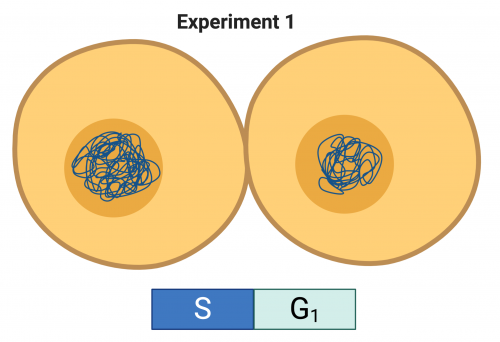
A cell in the S phase was fused with a cell in G1. What happened? The G1 cell immediately entered S.
What’s going on? It’s all about signaling (or, in this case, manipulation of signaling). Some molecule available in the “S” phase cell could induce the G1 phase cell to enter S (even if it wasn’t completely ready). Conclusion: some signaling molecule was inducing the cell’s progression through the cycle. That is why, by the way, I teach cell communication before I teach cell cycle regulation.
From there, we go into reading and quizzes that lead to an understanding of the idea of cell cycle checkpoints, as shown in the diagram below.
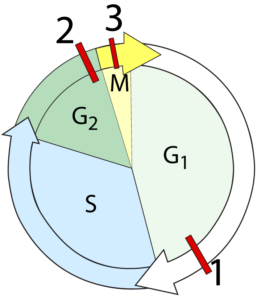
Next, students look at how the rise and fall of cyclins and MPF is what controls the movement of cells from G2 into M phase (which is a specific example of how passage through all of the various checkpoints works).

This culminates in reading and interacting with diagrams like the one below, showing how the interaction between mitotic cyclin and Cyclin-Dependent Kinase (CDK) leads to the formation of MPF, the molecule that induces the cell to move from G2 into M.
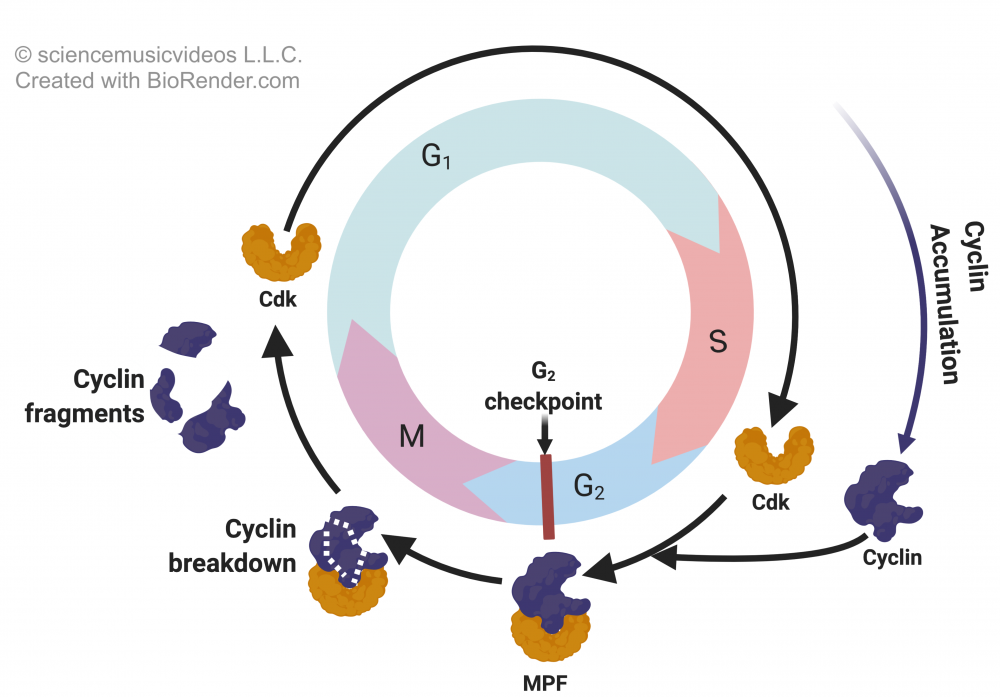
Note that the College Board has this exclusion statement: “Knowledge of specific cyclin-CdK pairs or growth factors is beyond the scope of the course and the AP Exam” I’m not sure if the diagram above violates that, but I can’t imagine how to teach how the process works without going into that level of detail.
Objectives for Cell Cycle Regulation (Topic 4.7)
You can see the College Board’s original objectives for Topic 4.7 in their Course and Exam Description, or in my condensed version of the same document (links are above). Here are these objectives in student-friendly form.
- Describe how the cell cycle is regulated (answers should include a general description of internal checkpoints, and how these checkpoints work to control progression through the cycle).
- Explain how interactions between cyclins and cyclin-dependent kinases control the cell cycle.
- Describe how disruptions to the cell cycle can lead to cancer.
- Explain how apoptosis is a regulated process resulting in cell death.
Cell Cycle Regulation tutorial on Learn-Biology.com
Our cell cycle regulation tutorial on Learn-Biology.com covers objectives 1 and 2 above very well. The tutorial is supported by this student learning guide (which your students already started when they learned about Cell Division and Mitosis in week 12).
Cancer: What AP Bio Students Need to Know.

After having learned about cell cycle regulation and cell communication, students are ready to take on understanding the connection between cell cycle dysregulation and cancer, and the mechanisms that underlie apoptosis. They can gain that understanding through this tutorial. This tutorial will guide students through
- the differences between normal cells and cancerous cells
- The role of mutations in proto-oncogenes and tumor suppressor genes in inducing cells to become cancerous.
- The cell signaling pathways that are connected with genes such as RAS, p53, and HER2.
Here are two signaling systems to know:
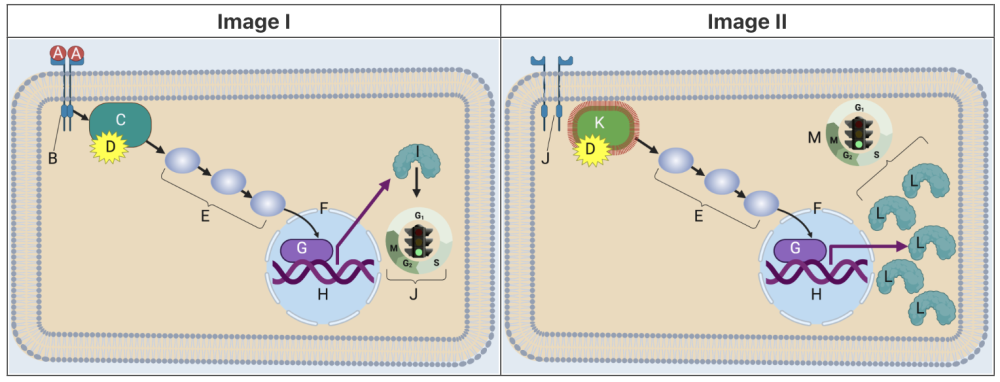

Cell Cycle Regulation and Cancer Biology Activities
To guide your students to mastery of the cell cycle, I recommend Flinn’s Cell Cycle Regulation POGIL
To cover objective 3 above, I recommend HHMI’s “The Eukaryotic Cell Cycle and Cancer.” HHMI also provides additional resources (including worksheets) on this page.
Week 15, Feedback (and Homeostasis)
General Notes about Teaching Feedback
The fun thing about teaching about feedback is that it lets you teach about human body systems, which students tend to find really interesting. In fact, in addition to the general ideas of homeostasis, negative feedback, and positive feedback, you can think of one meta-objective binding this entire topic together: what adaptations and processes allow humans and other animals to regulate their body temperature and their blood sugar levels? This material is pretty straightforward. In fact, as I advise in my general comments about teaching AP Bio using Learn-Biology.com, this is one topic that, if you’re pressed for time, you can assign to students to do completely independently during Winter or Spring break.
If you do that, be sure to check for understanding of negative and positive feedback loops in general, and your students’ ability to handle diagrams showing negative and positive feedback (even for systems that you haven’t taught them about). For example, if your students are confronted with the diagram below, they should be able to identify the conditions that decrease LH secretion, and those that increase it (despite the fact that you haven’t taught them anything about the reproductive system).

Objectives for Feedback
You can see the College Board’s original objectives for Topic 4.5 in their Course and Exam Description, or in my condensed version of the same document (linked above) Here are these objectives in student-friendly form (with some selected responses provided)
- Describe the function of feedback mechanisms (maintaining internal environments and responding to internal and external environmental changes).
- Define the physiological concept of a set point.
- Compare and contrast positive and negative feedback systems.
- Explain how negative feedback helps to maintain homeostasis (response: by returning a perturbed system back to its target set point).
- List and explain examples of negative feedback systems in organisms (responses can include blood sugar homeostasis through glucagon and insulin, thermoregulation,
- Explain how positive feedback works (by amplifying responses and processes in a way that increases the initial stimulus, which activates the response).
- List and explain examples of positive feedback systems in organisms (responses can include lactation in mammals, the onset of labor in mammalian childbirth, or fruit ripening).
Feedback and Homeostasis on Learn-Biology.com
Learn-Biology.com organizes learning about feedback into three tutorials, supported by this Topic 4.5 (Feedback and Homeostasis) Student Learning Guide
- Topic 4.5, Part 1: Homeostasis and Regulation (using thermoregulation as an illustrative example)
- Topic 4.5 Part 2: Feedback Loops
- Topic 4.5, Part 3: Blood Glucose Regulation (Illustrative Example)
- Topic 4.5, Part 4: Understanding Diabetes (Illustrative Example)
Here are some notes to guide you through the module.
In Topic 4.5, Part 1: Homeostasis and Regulation I use thermoregulation as an entry point to the general concept of homeostasis. Why? While this kind of curriculum-expanding thinking is a dangerous temptation that I usually avoid, I can’t stand the idea that my students will leave my class without understanding the difference between endotherms and ectotherms. And it seems to come up throughout the course. Why do the beans in a respirometer increase their oxygen consumption at higher temperatures? They’re ectotherms. Why is the opposite (within limits) true for a mammal? Because we’re endotherms. It’s all about thermoregulation.
The next tutorial is Topic 4.5 Part 2: Feedback Loops. Using what we’ve learned in the previous tutorial, we focus on how negative feedback loops are used in thermoregulation. This begins by looking at home thermostats…

…and culminates in students’ being able to explain diagrams like this:
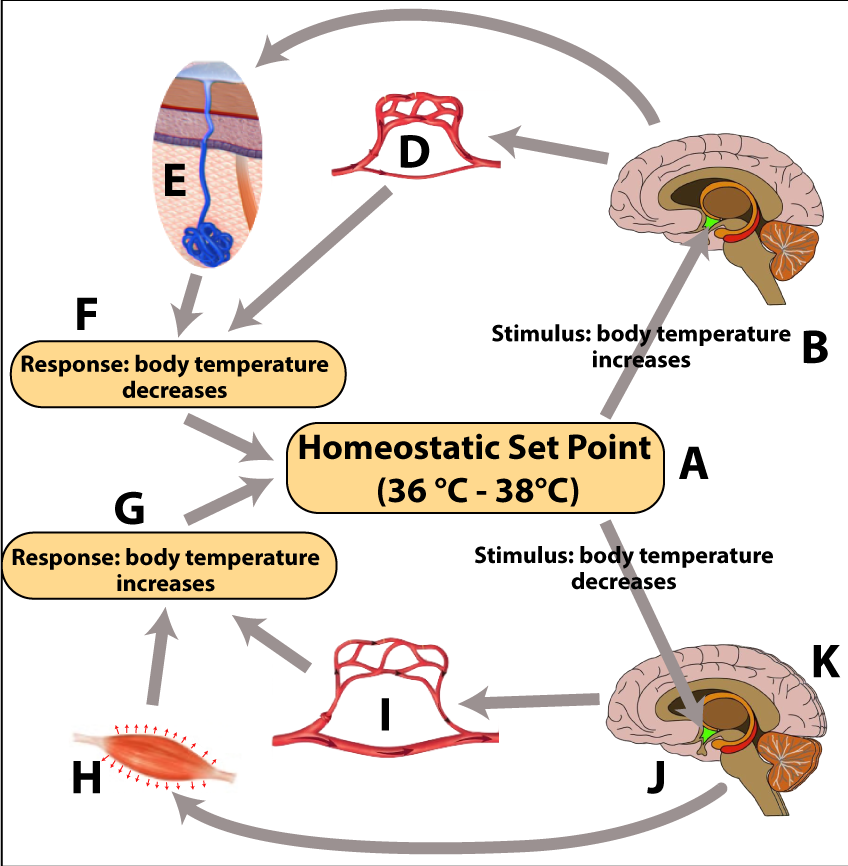
To demonstrate how positive feedback works, I use several illustrative examples:
- Oxytocin and the onset of labor.
- Fruit ripening and ethylene gas production in fruit.
- Platelet aggregation during blood clotting.
The next tutorial on this topic is Topic 4.5, Part 3: Blood Glucose Regulation. Our focus here is how the body maintains a blood glucose set point through the action of insulin and glucagon.
In terms of insulin, the tutorial will leave your students with mastery of diagrams like this:
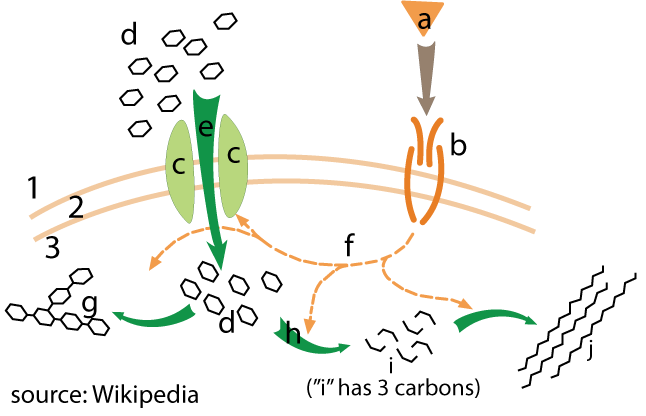
In terms of glucagon, your students should easily be able to master this diagram: That’s because in liver tissue, glucagon’s activity is very similar to that of epinephrine. That’s the hormone we studied extensively in topics 4.1 to 4.4.
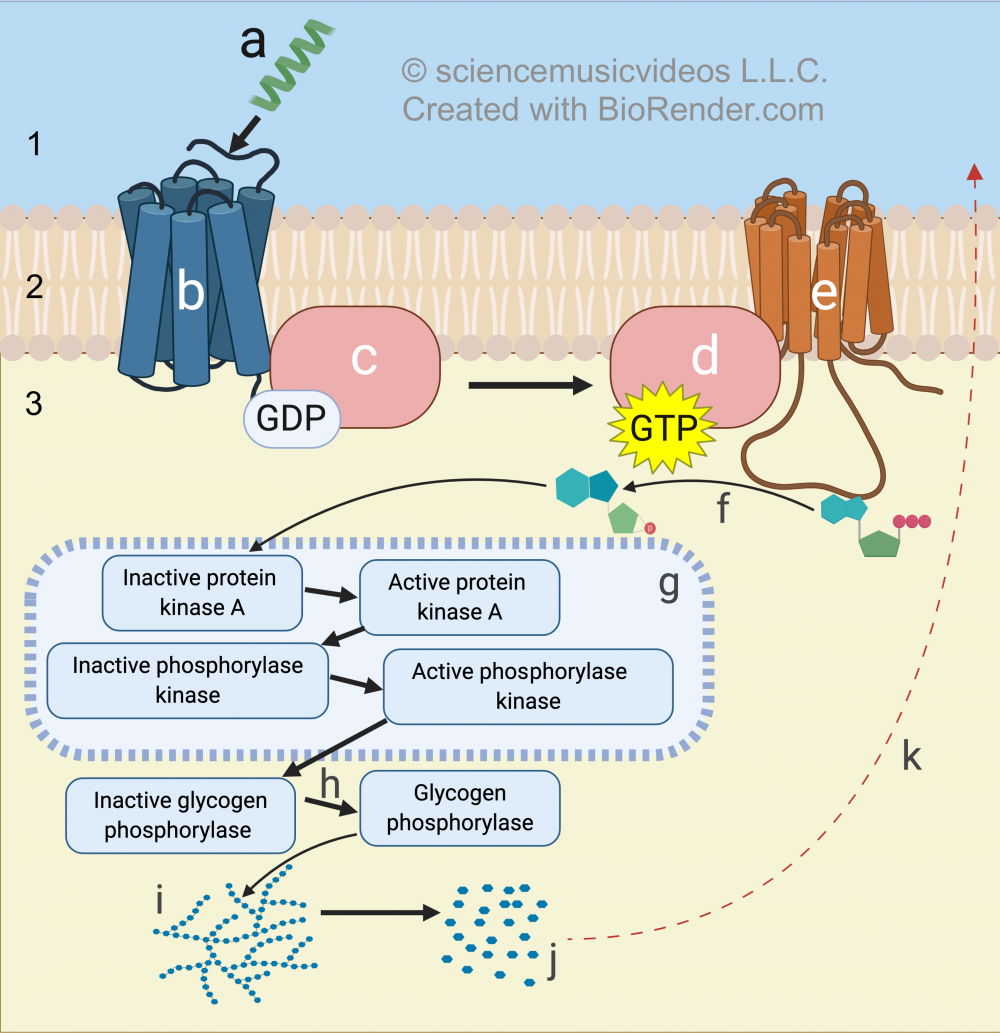
Understanding the effect of both insulin and glucagon will leave your students with mastery of diagrams like this:
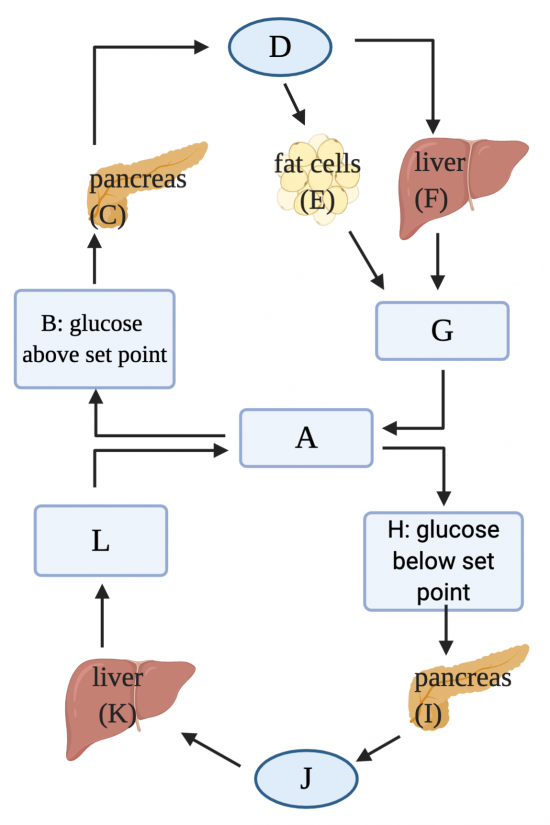
For the last tutorial on this topic, Topic 4.5, Part 4: Understanding Diabetes, we look at how when blood sugar regulation breaks down, diabetes can result. If you’re like me, then you’ll feel great about giving your students some important information that might impact their nutrition choices, lengthen their lives, and set them up for the AP Bio exam.
If you have time for another illustrative example of regulation, you can assign our tutorial on ADH and Osmoregulation. This is not part of the AP v2.0 curriculum, but you can easily assign it, either directly from the tutorial or by using Manage Quizzes/Decks in Learn-Biology.com/login.
Additional Feedback Activities
In terms of classroom resources for feedback and homeostasis., Flinn offers two POGILS
- Feedback mechanisms
- Blood sugar regulation
Summative Activities for Unit 4
To help your students pull together what they’ve learned from Unit 4,
- Send them to this cumulative review page, where they’ll find, objectives, flashcards, and click-on challenges.
- Complete the Unit 4 progress check questions on AP Classroom.
Link back to the Teacher’s Guide Table of Contents
